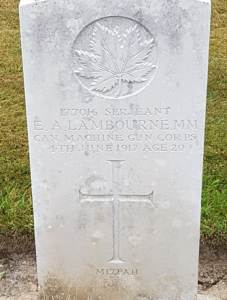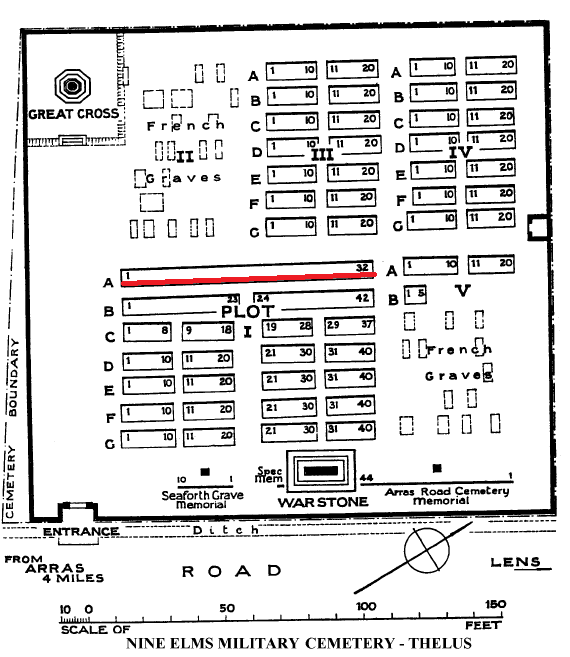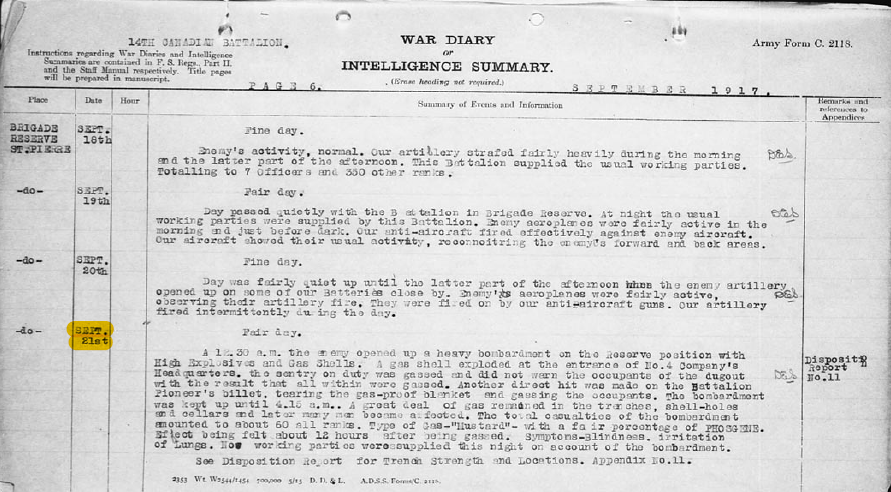Westmount, Quebec – 26 February 2017: The RMR Foundation recently learned who was responsible for establishing Nine Elms cemetery, where 80 RMR’s are laid out together in one row, sorted alphabetically and by rank: Sergeant William James Lambourne.
Captain (retired) Hamilton Slessor, the force behind 2014-15’s This Day In RMR History, has collaborated with Dwayne Johnstone, the grandson of Sergeant Lambourne to produce this detailed summary. All RMR’s owe a debt of honour to Sergeant Lambourne, a man who did his duty well.
“William James Lambourne was born at Winslow, Buckinghamshire on January 27th 1894 to James Thomas Lambourne and his wife Ellen Ann. William was one of nine children – he had three sisters and five brothers. The family later moved to Bicester in Oxfordshire and after schooling William traveled to Montreal accompanied by his brothers Louis Henry and Ernest Arthur .
When war broke out in August 1914 while they were in Montreal, William enlisted with the 1st Canadian Grenadier Guards. Almost immediately he was transferred to the 14th Bn. C.E.F. (Royal Montreal Regiment) upon the formation of the 14th Bn. in September 1914. After their brief training at Valcartier, Quebec, he proceeded on October 3rd with the battalion from Quebec to England aboard the S.S. Andania as part of the First Canadian Contingent. Following a long wet winter spent on Salisbury Plain at West Down South, the battalion arrived at St. Nazaire, France on February 15, 1915.
In February 1916 William was sent on a two week course at the Canadian Division Training School in the field. Following this he was granted an 8 day leave to the UK. which presumably was used to visit family in Bicester. While on leave he was promoted to the rank of Corporal effective March 17th.
On June 3rd 1916 William was reported missing but three days later he had rejoined the battalion, and was soon promoted to Lance-Sergeant on June 19th.. In November 1916 he was sent on a Gas Training course, and on December 28th of that year he was promoted to Sergeant.
During the winter of 1916-17 the 14th Battalion was involved in regular tours of trench duty. In the spring of 1917 the Canadian Corps, in conjunction with the British Third Army, were assigned the task of capturing Vimy Ridge which French armies had been unable to re-take from the German Army. This ridge of high ground was important to the occupiers because of its commanding view over the surrounding plains. The 14th Battalion’s position in the planned assault was in the centre of the 3rd Brigade of the 1st Canadian Division, flanked on its left by the 16th Bn. Canadian Scottish, and on its right by the 15th Bn. 48th Highlanders.
The 14th Battalion Special Operation Order No. 132 (Pt II – Administration) of April 4, 1917, was issued in preparation for the Canadian attack on Vimy Ridge which took place on April 9th, 1917. Sergeant William Lambourne was assigned an undoubtedly unpleasant task. The assignment read as follows:-
“4. Burial of the Dead and Clearance of the Battlefield
(a) Owing to a shortage of commissioned Officers existing Sergeant Lambourne is herewith appointed to supervise the burial of our own and German dead and to clear the battlefield.
(b) The area allotted to the 14th Canadian Battalion is from and including ZWOLFER WEG to and including EISNER KREUZ WEG across the entire brigade frontage.” [iv]

During the course of the Battle for Vimy Ridge the 14th Battalion suffered heavy casualties – 6 officers killed or fatally wounded, 3 officers wounded, 92 ORs killed and 173 ORs wounded.
Sergeant Lambourne carried out his assignment in a methodical and exemplary way, with the result that 80 men of the 14th Bn. who had been killed in the operation were gathered into what was initially a regimental burial ground. This later became what is now known as Nine Elms Military Cemetery, Thelus. The Commonwealth War Graves Commission describes the history of this cemetery as follows:
“Thelus is a village in the Pas de Calais, region of France, about 6.5 kilometres north of Arras and 1 kilometre east of the main road from Arras to Lens. The cemetery is on the western side of the main road and about 1.5 kilometres south of the village. ‘NINE ELMS’ was the name given by the Army to a group of trees 460 metres East of the Arras-Lens main road, between Thelus and Roclincourt. The cemetery was begun, after the capture of Vimy Ridge, by the burial in what is now Plot I, Row A of 80 men of the 14th Canadian Infantry Battalion, who fell on the 9th April 1917.” [ii]
What makes the fulfillment of Sergeant Lambourne’s assigned task unusual was the fact that in gathering and laying out for burial the casualties of the 14th Battalion he laid them out (with a few exceptions) very methodically first by rank, and then alphabetically within rank order. This was reportedly the first and perhaps only time that this has ever occurred in a Commonwealth War Graves Commission cemetery of which there are over 23,000 scattered world-wide.
Well done, good and faithful soldier!!
Sergt. Lambourne’s service sheets show that although he was later sent on a “Gas Training” course, and served as a Brigade Gas NCO for a short period there is no indication of any admission to hospital at any time. However, his grandson advises that due to the effects of gassing at Cité St. Pierre, near Lens, in 1917, Sergt. Lambourne’s life was difficult after the war. According to the 14th Battalion’s War Diaries, the battalion was in the reserve position at Cité St. Pierre a suburb of North Western Lens when on September 21, 1917 between the hours of 12:30am – 04:15 the battalion was gassed with Mustard and Phosgene gas, amassing approximately 60 casualties of all ranks.
In November of 1917 Sergeant Lambourne was posted to the Cdn. 3rd Brigade as “Gas NCO,” rejoining the 14th Bn. six weeks later. He remained with the RMR until May 31st 1919 when he received his discharge at Whitley in England, following which he returned to Bicester, his family home. He soon found employment as a coach painter with Legge’s Coach Works, at Chiswick. It was there he invented the current day spray paint gun; however, he was unable to obtain a patent for this invention.

William married Grace Cockman in 1929 in Brentford, Middlesex, and moved to London where they raised 4 daughters. William acted as a lay minister at St Paul’s Church in Hounslow, a suburb of London.
William James Lambourne passed away on Dec 6th 1938 and is buried at St Edburg’s Church Cemetery in Bicester, Oxfordshire
Of the three Lambourne brothers who had travelled to Montreal before the War, the eldest, Louis Henry Lambourne, apparently did not enlist with the Canadian Army and died at Montreal in November 1973.
 However, one year after William enlisted his younger brother Ernest Arthur Lambourne enlisted at Montreal on September 20, 1915, with the 87th Bn. C.E.F. Canadian Grenadier Guards for service overseas and was assigned service no. 177016. Ernest later attained the rank of Sergeant and was killed in action on June 4, 1917 while serving with the 4th Canadian Division Machine Gun Company. He was awarded posthumously the Military Medal for his bravery in the field and was buried in Cabaret-Rouge British Cemetery, Pas de Calais, France, Grave Ref.: II. E. 2.
However, one year after William enlisted his younger brother Ernest Arthur Lambourne enlisted at Montreal on September 20, 1915, with the 87th Bn. C.E.F. Canadian Grenadier Guards for service overseas and was assigned service no. 177016. Ernest later attained the rank of Sergeant and was killed in action on June 4, 1917 while serving with the 4th Canadian Division Machine Gun Company. He was awarded posthumously the Military Medal for his bravery in the field and was buried in Cabaret-Rouge British Cemetery, Pas de Calais, France, Grave Ref.: II. E. 2.
[1] Dwayne Johnstone, Ancaster, Ontario [2] Ibid [3] 14th Bn. C.E.F., Part II Orders, April 1917. http://data2.collectionscanada.ca/e/e044/e001090624.jpg [4] Commonwealth War Graves Commission. http://www.cwgc.org/find-a-cemetery/cemetery/30201/NINE%20ELMS%20MILITARY%20CEMETERY,%20THELUS [5] Ibid [6] Ibid [7] 14th Bn. C.E.R. War Diary September 1917. http://data2.collectionscanada.ca/e/e044/e001090792.jpg [8] McMaster University, William Ready Division Archives & Research Collection, World War 1 Trench Maps,[Lens] 36c.SW, June 26, 1917 http://digitalarchive.mcmaster.ca/islandora/object/macrepo%3A4161/-/collection [9] Dwayne Johnstone, Ancaster, Ontario





